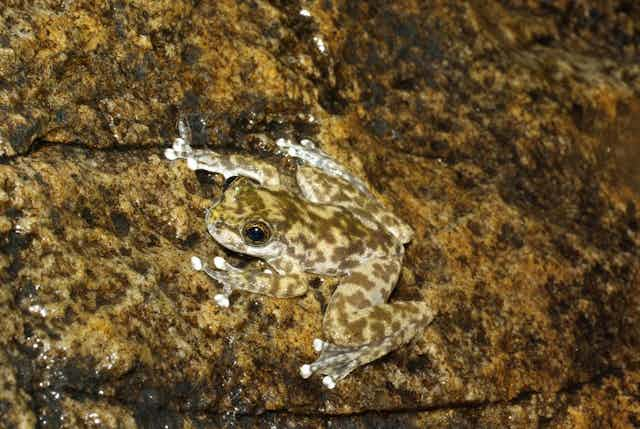Torrent frogs are an interesting group of frogs found in the rainforests of north-east Australia. There are four species in the group: the Mountain Mistfrog (Litoria nyakalensis), the Armoured Mistfrog (Litoria lorica), the Waterfall Frog (Litoria nannotis) and the Common Mistfrog (Litoria rheocola).
All of these species were once abundant along streams in the Wet Tropics region of northeastern Queensland. In the late 1980s and early 1990s the populations suffered dramatic declines. The Mountain and Armoured mistfrogs, both localised species from the uplands, disappeared completely. The two more widespread species disappeared from the uplands but remain lower down.
All four species are well adapted to life on mountain streams, hence the name. The adult frogs live around fast-flowing sections of streams, near waterfalls and cascades. The Armoured Mistfrog and the Waterfall Frog live only near the splash zones of waterfalls, sticking to the wet rocks and jumping in the rushing water when disturbed.
The frogs feed on invertebrates around the stream and in neighbouring forest. Torrent frog tadpoles have discs around their mouths, allowing them cling to rocks in fast-flowing streams and graze on algae.
Status
The Waterfall Frog and Common Mistfrog were abundant through most of the Wet Tropics rainforest until the catastrophic population declines that affected these and other Australian frogs, and amphibians globally. Little was known about the more localised upland species, the Armoured Mistfrog and the Mountain Mistfrog, but it appears they were quite common where they lived prior to the declines.
The primary reason for the decline is amphibian chytrid fungus, which has affected many amphibian communities around the globe. Declines were worst in higher elevations, where cooler and moister environments are ideal for the fungus. In the case of the Mountain and Armoured mistfrogs, restricted to the uplands, the impact of these outbreaks was devastating. Both species appeared to go extinct.

There have been some positive findings since the declines. Thriving populations of some torrent frogs were discovered in a thin strip of drier forest along the western edge of the Wet Tropics rainforest. While these frogs are typically associated with rainforest, they also occur downstream where streams flow into dry forest types.
In some areas, the rainforest populations have largely vanished while high-density populations survive downstream in dry forest. Amongst these dry forest discoveries was a population of the Armoured Mistfrog, a species not seen for 16 years and thought extinct. Interestingly, these populations in the dry forests are coexisting with chytrid fungus. Warmer temperatures may be the reason.
Also encouraging are signs of recovery in the Waterfall Frog and Common Mistfrog, which can now be once again found in some streams at higher elevations. They still suffer periodically from chytrid fungus, especially in winter, but the populations are persisting and apparently continuing to expand.
Unfortunately, despite intensive searches, the Mountain Mistfrog has not been found again and is feared extinct.
Threats
The primary reason for the population declines of torrent frogs is chytridiomycosis, the disease caused by chytrid fungus. The rediscovery of the the Armoured Mistfrog brings hope that other missing species might still persist, both in Australia and elsewhere in the world.
All torrent frogs were initially thought to be restricted to rainforests, however we now know that they also occur in the nearby dry forest areas. Many of these remain to be explored.
How frogs and chytrid coexist in these environments is the focus of our current research. We hypothesise it’s because the frogs haver higher body temperatures in dry forest because of the lack of canopy cover. The rocks in the forest heat up during the day, and stay hot for hours after dark. Because these frogs are nocturnal, they sit around on these rocks, which means they stay warmer (frogs are ectotherms, so their body temperature is determined by the environment they live in).
Chytrid fungus does poorly at warmer temperatures. Warmer temperatures may also allow the frogs’ immune system to better respond to the infection.
Strategy
After the rediscovery of the Armoured Mistfrog we surveyed similar habitats on the western edge of the Wet Tropics for more populations, and for other species. These western flowing streams have seen few surveys because as they are remote and have been considered marginal habitat.

Despite discovering many new populations of the Waterfall Frog and the Common Mistfrog, we did not find any more populations of Armoured Mistfrogs. This species remains known from one population, meaning it is time to consider the next step in the conservation of this species.
Although captive breeding has been suggested for many critically endangered frogs, this species is not a good candidate for such an approach. Firstly, their biology associated to fast flowing streams and waterfalls makes their captive husbandry complex, especially given we know essentially nothing about their reproductive biology.
Translocation is the most viable option for establishing a second population. Highly suitable habitat exists in an area close to the known population. Details and methodology of a potential translocation are currently being assessed in collaboration with the Environment and Heritage Protection branch of the Queensland Government.
Conclusion
Amphibian declines caused by amphibian chytrid fungus have decimated frog populations in Australia and globally. The Australian torrent frogs exemplify the impacts of this disease, with two species much reduced, one found in only a single population, and a fourth apparently extinct.
However, recent rediscoveries and research suggest population recovery in two of the species and provide ways forward for securing the future of another. There is also hope that other frogs may be rediscovered in other parts of the world, particularly if searches are conducted in different habitats near where the frogs were once found.
The Conversation is running a series on Australian endangered species. See it here.

